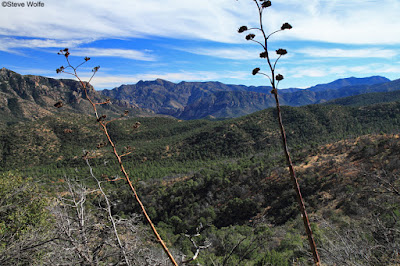Look at that expression; I call it The Little Man Napoleonic Complex -- "Don't mess with me!" even though he's only 4 inches tall. He was also closely guarding the feeder on the agave, perching above it --
He looks much more friendly there...Most of the hummingbirds have migrated south. At the height of fall migration I had 5 feeders going and had emptied a 25-pound bag of sugar in about a month; now I've had another bag of sugar for around 2 months. The only ones that are left at Faranuf are Mr. Broad-billed (more BBs are staying later here in SE Arizona, even up in Tucson) and a few Anna's, who are non-migratory, and I now have only one feeder up on the front porch and one in back. Rufous, Black-chinned, Broad-tailed, Broad-billed -- they've all left, at least my back yard. I never saw the variety of species that visited the feeders of other folks living nearby -- Magnificent, Blue-throated, even the rarely-seen Plain-capped Starthroat. Perhaps next year, when Faranuf earns a spot on the hummingbirds' map of Places to Visit...
I've been here over 3 months now and have only gone up to the high Chiricahuas once, with friends Mark and Lori and Bob, a friend visiting from the South Bay of Los Angeles. Now that it's nearly winter it's almost too late, but the weather lately has been warm for even up there, and there's been very little precipitation, even on the 10-day forecast. So a trip up top was long overdue. I packed up my 500 f/4 and landscape lens and headed up Cave Creek Canyon that turns into the unpaved trans-Chiricahua road that crosses over to the west side. 5 of the 9 life zones are found here, and all are within a driving distance of about 20 miles. The Chiricahuas are the range part of the "basin and range" system of mountains, and like most of the other mountains in that category have a steep elevation gain over very little distance. For example, Portal is at 4700 feet, and Chiricahua Peak, highest in the Chiricahuas, is at 9.759 feet at an air distance of approximately 15 miles. So the 5 life zones found here are relatively close to one another. Just beyond the Southwestern Research Station the road across the Chiricahuas is unpaved and closed during the winter -- "Limited Maintenance" during the rest of the year. Once you get out of the creek canyon you're treated to spectacular views looking east, and back south to Cave Creek Canyon and Silver Peak --
Northeast
Southeast with Cave Creek Canyon in the distance (and the unpaved road in the right foreground)
Another view southeast
The mountain road winds up until you reach Onion Saddle, where the road down the west side begins; Onion Saddle is at 7600 feet --
It's windy -- and a bit cold -- on the spur road to Rustler and Barfoot Parks, and I come across a spot with snow from the winter storm nearly 2 weeks ago. Here's the intersection of the Rustler Park and Barfoot roads --
The barren trees you see in the background are from the Horseshoe 2 fire in June 2011, which burned quite a bit of the high Chiricahuas. But the high-mountain feel is still here. Small flocks of Yellow-eyed Juncos are here, along with Pink-sided Dark-eyed Juncos, which are common here from October to April --
The views along the road stretch for nearly a hundred miles to the east -- basin and range, basin and range --
Back down at the Turkey Creek crossing, where the road to Paradise intersects with the trans-Chiricahua road, I see a Ruby-crowned Kinglet flitting among the trees --
Raptors soaring and stooping in the wind, an American Robin on top of an agave, a Sapsucker flying between oak trees, Apache and Ponderosa pine stands -- it's truly another in a long list of amazing places here in the Chiricahuas. And heading back, it's a thrilling feeling to know my house lies on the other side of that mountain --











No comments:
Post a Comment